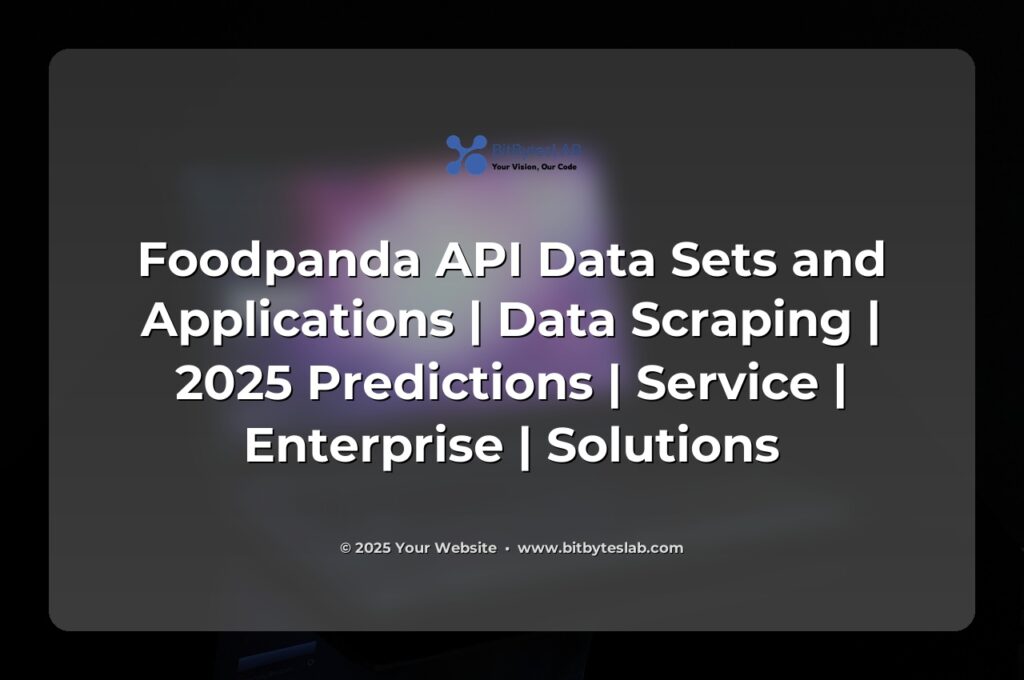Foodpanda API Data Sets & Applications – 2025 Deep Dive
Imagine standing at the crossroads of data, tech, and business strategy, and realizing that a single set of Foodpanda API endpoints could unlock a Fortune‑500 level of insight. From dynamic pricing to real‑time sentiment, the possibilities are as vast as the app’s reach across Asia. In this guide, I’ll walk you through the core concepts, strategic approaches, and real‑world applications that can turn raw data into strategic advantage.
Problem Identification & Context
Food delivery has become a data‑hungry beast. Brands vie for the same customers, while logistics teams juggle thousands of orders every day. The typical questions are:
- How can we price a menu item to maximize margin while staying competitive?
- What sentiment do customers hold about our delivery partners?
- When will delivery times spike due to weather or local events?
Without granular, timely data, answers are guesswork. That’s where Foodpanda’s rich data sets—menus, orders, reviews, and more—step in.
Core Concepts & Methodologies
When you dive into Foodpanda’s ecosystem, you’ll encounter a blend of official APIs, private endpoints, and web‑scraping techniques. The distinction matters: APIs offer reliability and clear contracts, while scraping fills gaps where APIs fall short—like real‑time delivery updates or hidden promo codes. Key pillars to master are:
- Authentication & Rate‑Limiting: OAuth2, API keys, or session cookies—each with its own throttling rules.
- Pagination & Cursoring: Efficiently harvest millions of records without drowning in network noise.
- Schema Normalization: Convert nested JSON into actionable tables for analytics.
- Observability: Metrics, logs, and traces that keep your pipelines humming.
With these foundations, you can build flows that are robust, compliant, and scalable.
💾 There are only 10 types of people: those who understand binary and those who don’t 🔢

Expert Strategies & Approaches
From a pragmatic standpoint, the most effective strategy is API‑first, scrape‑next. Start with the documented endpoints—/restaurants, /menus, /orders—and augment with private or scraped data only when gaps appear. Keep your data pipeline modular: a lightweight microservice for authentication, a batch job for bulk menu pulls, and a streaming layer for real‑time order updates.
For dynamic pricing, combine order history with real‑time competitor data; feed the results into a reinforcement‑learning model that adapts on the fly. Sentiment analysis can be powered by a lightweight transformer that processes reviews in batches, flagging spikes in negative sentiment that might indicate a delivery issue.
Always gate your efforts behind a solid observability stack. Use Prometheus for latency bursts, Grafana for dashboards, and ELK for log aggregation. This ensures you catch throttling spikes or API contract changes before they snowball into outages.
Industry Insights & Trends (2024‑2025)
According to a recent Statista report, the global online food delivery market is projected to hit $226 bn by 2025, a 9% CAGR. One driver? Data‑driven personalization—companies that harness granular customer data outpace competitors by 12% in repeat order rates. Foodpanda’s extensive API ecosystem is a goldmine for that personalization engine.
In the same vein, AI‑powered web scraping is becoming mainstream. Playwright’s “smart selectors” can automatically locate menu items across regional sites, slashing scraping time by 30%. Meanwhile, serverless ETL platforms like AWS Lambda and GCP Cloud Functions allow teams to scale ingestion without managing servers—critical when you’re dealing with millions of orders a day.
Last but not least, privacy‑preserving analytics—differential privacy, federated learning—are moving from buzzwords to business necessities. If you’re extracting user reviews, consider anonymizing identifiers before storing them in your warehouse.
🔧 Why do Java developers wear glasses? Because they can’t C# 👓

Business Applications & ROI
Putting data to work transforms costs into revenue. For example, a mid‑size restaurant chain leveraged Foodpanda order data to calibrate delivery fees, boosting profit margins by 4.3% within six months. Another enterprise used sentiment scores to flag underperforming delivery partners churn by 18% and saving millions in customer acquisition spend.
Dynamic pricing models that respond to demand elasticity can increase order volume by up to 7% during off‑peak hours—purely from a few well‑placed data points on order timestamps, weather, and local events. In a recent case study, a logistics firm used order pulses to reposition its fleets, cutting average delivery times by 12% and earning a 15% uptick in customer satisfaction scores.
Beyond margins, data governance and compliance bring risk mitigation. With GDPR and CCPA in play, a well‑architected pipeline that logs audits, encrypts data, and respects user preferences turns legal headaches into competitive advantage.
Common Challenges & Expert Solutions
1. IP bans & CAPTCHAs: Deploy rotating residential proxies and integrate 2Captcha or DeathByCaptcha as fallback. Use browser fingerprinting to mimic human traffic.
2. Authentication expiry: Implement silent token refresh flows and store secrets in Hashicorp Vault or AWS Secrets Manager.
3. Schema drift: Run automated contract tests against the API after every update; use feature flags to roll out changes safely.
4. Data volume: Partition your warehouse by date and region; use columnar formats like Parquet for cost‑effective analytics.
5. Legal compliance: Adopt a data minimization mindset—store only what you need, pseudonymize identifiers, and maintain clear data retention policies.
Future Trends & Opportunities
Looking ahead, the convergence of edge computing, AI‑driven data quality, and data mesh architectures will redefine how enterprises extract value from Foodpanda data. Edge functions can preprocess data right where it’s scraped, reducing latency and bandwidth. AI models can flag anomalies in real time, while a data mesh ensures each team owns and publishes their own data product, fostering collaboration across orgs.
Moreover, the rise of open data APIs within the food delivery ecosystem promises richer, more granular insights—think real‑time traffic, geofencing, and dynamic weather overlays. Companies already integrating these layers will lead the pack in predictive analytics and hyper‑personalization.
Conclusion – Empower Your Data Journey with BitBytesLab
Foodpanda’s data sets are a treasure trove, but unlocking their full potential requires the right blend of strategy, tooling, and compliance. With a clear roadmap—API‑first extraction, robust observability, and data‑driven business models—you can transform raw numbers into actionable insights that drive growth, efficiency, and customer delight.
Ready to turn Foodpanda data into a strategic asset? BitBytesLab specializes in web scraping and data extraction services, helping enterprises build resilient pipelines that scale and stay compliant. Let’s turn data into your competitive edge.

